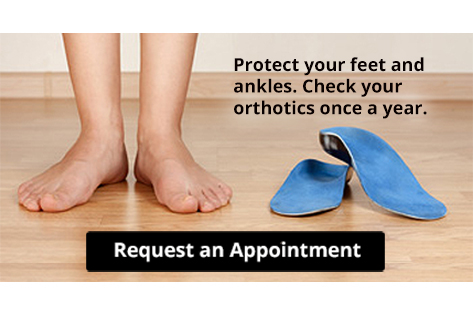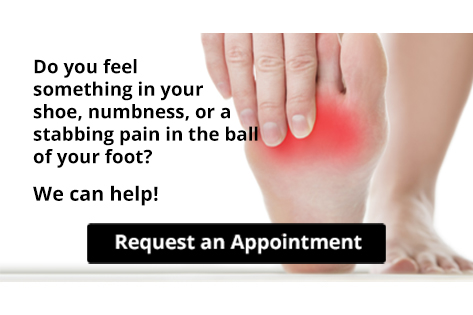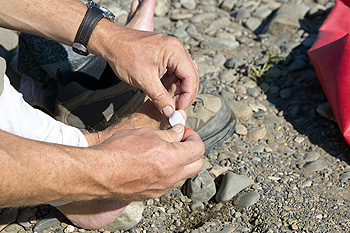Blog
Reminder: When Was the Last Time...?
Is Morton’s Neuroma Painful?
 A condition referred to as Morton’s neuroma generally causes severe pain on the ball of the foot or between the toes. The plantar nerve undergoes degeneration and as a result, it becomes thickened and inflamed. Women are more prone to acquire this condition because of the stress and pressure endured by the feet, which is generally caused by the type of footwear that is worn. The symptoms of this ailment typically consist of pain that is experienced between the third and fourth toes or on the bottom of the feet. The pain will often follow a feeling of numbness or tingling and may increase during intense activities. Treatment may consist of incorporating lifestyle changes, including choosing to wear shoes that fit correctly and avoiding any extreme and excessive activities. Please consider scheduling a consultation with a podiatrist for a proper diagnosis and to learn about the best treatment options for you, which may include surgery.
A condition referred to as Morton’s neuroma generally causes severe pain on the ball of the foot or between the toes. The plantar nerve undergoes degeneration and as a result, it becomes thickened and inflamed. Women are more prone to acquire this condition because of the stress and pressure endured by the feet, which is generally caused by the type of footwear that is worn. The symptoms of this ailment typically consist of pain that is experienced between the third and fourth toes or on the bottom of the feet. The pain will often follow a feeling of numbness or tingling and may increase during intense activities. Treatment may consist of incorporating lifestyle changes, including choosing to wear shoes that fit correctly and avoiding any extreme and excessive activities. Please consider scheduling a consultation with a podiatrist for a proper diagnosis and to learn about the best treatment options for you, which may include surgery.
Morton’s neuroma is a very uncomfortable condition to live with. If you think you have Morton’s neuroma, contact Shaun J. Limon, DPM and Lisa Griffith-Limon, DPM of Limons Foot & Ankle Care. Our doctors will attend to all of your foot care needs and answer any of your related questions.
Morton’s Neuroma
Morton's neuroma is a painful foot condition that commonly affects the areas between the second and third or third and fourth toe, although other areas of the foot are also susceptible. Morton’s neuroma is caused by an inflamed nerve in the foot that is being squeezed and aggravated by surrounding bones.
What Increases the Chances of Having Morton’s Neuroma?
- Ill-fitting high heels or shoes that add pressure to the toe or foot
- Jogging, running or any sport that involves constant impact to the foot
- Flat feet, bunions, and any other foot deformities
Morton’s neuroma is a very treatable condition. Orthotics and shoe inserts can often be used to alleviate the pain on the forefront of the feet. In more severe cases, corticosteroids can also be prescribed. In order to figure out the best treatment for your neuroma, it’s recommended to seek the care of a podiatrist who can diagnose your condition and provide different treatment options.
If you have any questions, please feel free to contact our offices located in Bradenton and Lakewood Ranch, FL . We offer the newest diagnostic and treatment technologies for all your foot care needs.
Read more about Morton's NeuromaThe Importance of Maintaining Proper Foot Care for Elders
 It’s important to maintain proper foot care, and it’s especially wise if you are elderly. When your feet feel good, it’s easier to stay active by incorporating walking into your daily routine. The benefits of this include possibly preventing falls from occurring as a result of having strong feet, in addition to sustaining proper balance. Recent research has suggested that by monitoring the health of your feet, certain complications may become noticeable, such as arthritis and poor blood circulation. There are several measures that can be taken to ensure proper foot care, including trimming the toenails frequently, washing the feet daily, and utilizing a moisturizer that aids in keeping the skin soft. If it's difficult to bend down to complete the necessary tasks that are needed to maintain proper foot care, please consult with a podiatrist for assistance.
It’s important to maintain proper foot care, and it’s especially wise if you are elderly. When your feet feel good, it’s easier to stay active by incorporating walking into your daily routine. The benefits of this include possibly preventing falls from occurring as a result of having strong feet, in addition to sustaining proper balance. Recent research has suggested that by monitoring the health of your feet, certain complications may become noticeable, such as arthritis and poor blood circulation. There are several measures that can be taken to ensure proper foot care, including trimming the toenails frequently, washing the feet daily, and utilizing a moisturizer that aids in keeping the skin soft. If it's difficult to bend down to complete the necessary tasks that are needed to maintain proper foot care, please consult with a podiatrist for assistance.
Proper foot care is something many older adults forget to consider. If you have any concerns about your feet and ankles, contact Shaun J. Limon, DPM and Lisa Griffith-Limon, DPM from Limons Foot & Ankle Care. Our doctors can provide the care you need to keep you pain-free and on your feet.
The Elderly and Their Feet
As we age we start to notice many changes in our body, but the elder population may not notice them right away. Medical conditions may prevent the elderly to take notice of their foot health right away. Poor vision is a lead contributor to not taking action for the elderly.
Common Conditions
- Neuropathy – can reduce feeling in the feet and can hide many life-threatening medical conditions.
- Reduced flexibility – prevents the ability of proper toenail trimming, and foot cleaning. If left untreated, it may lead to further medical issues.
- Foot sores – amongst the older population can be serious before they are discovered. Some of the problematic conditions they may face are:
- Gouging toenails affecting nearby toe
- Shoes that don’t fit properly
- Pressure sores
- Loss of circulation in legs & feet
- Edema & swelling of feet and ankles
Susceptible Infections
Diabetes and poor circulation can cause general loss of sensitivity over the years, turning a simple cut into a serious issue.
If you have any questions please feel free to contact our offices located in Bradenton and Lakewood Ranch, FL . We offer the newest diagnostic and treatment technologies for all your foot and ankle needs.
Read more about Elderly and their FeetWhy Live with Pain and Numbness in Your Feet?
Symptoms of Rheumatoid Arthritis
 If you are experiencing swelling, pain and stiffness in the toes, you may have what is referred to as rheumatoid arthritis. The toes are consistently bent in a downward position, making it difficult to walk. Additionally, it’s common for bunions to develop, which is a small bony protrusion on the side of the big toe. Many people endure pain in the entire foot, and will often notice the nails have become separated from the nail bed. In the desire to obtain relief the gait is often altered affecting the ball of the foot. Recent research has shown that it may be beneficial to wear shoes that provide adequate room for the toes to move about freely, in addition to avoid wearing high heels. There are several ways to treat this condition depending on the extent of the damage that has been incurred. If you are afflicted with this condition it’s suggested to schedule a consultation with a podiatrist to determine the severity of this ailment, and discuss the best treatments options available.
If you are experiencing swelling, pain and stiffness in the toes, you may have what is referred to as rheumatoid arthritis. The toes are consistently bent in a downward position, making it difficult to walk. Additionally, it’s common for bunions to develop, which is a small bony protrusion on the side of the big toe. Many people endure pain in the entire foot, and will often notice the nails have become separated from the nail bed. In the desire to obtain relief the gait is often altered affecting the ball of the foot. Recent research has shown that it may be beneficial to wear shoes that provide adequate room for the toes to move about freely, in addition to avoid wearing high heels. There are several ways to treat this condition depending on the extent of the damage that has been incurred. If you are afflicted with this condition it’s suggested to schedule a consultation with a podiatrist to determine the severity of this ailment, and discuss the best treatments options available.
Because RA affects more than just your joints, including the joints in your feet and ankles, it is important to seek early diagnosis from your podiatrist if you feel like the pain in your feet might be caused by RA. For more information, contact Shaun J. Limon, DPM and Lisa Griffith-Limon, DPM of Limons Foot & Ankle Care. Our doctors will assist you with all of your podiatric concerns.
What Is Rheumatoid Arthritis?
Rheumatoid Arthritis (RA) is an autoimmune disorder in which the body’s own immune system attacks the membranes surrounding the joints. Inflammation of the lining and eventually the destruction of the joint’s cartilage and bone occur, causing severe pain and immobility.
Rheumatoid Arthritis of the Feet
Although RA usually attacks multiple bones and joints throughout the entire body, almost 90 percent of cases result in pain in the foot or ankle area.
Symptoms
- Swelling and pain in the feet
- Stiffness in the feet
- Pain on the ball or sole of feet
- Joint shift and deformation
Diagnosis
Quick diagnosis of RA in the feet is important so that the podiatrist can treat the area effectively. Your doctor will ask you about your medical history, occupation, and lifestyle to determine the origin of the condition. Rheumatoid Factor tests help to determine if someone is affected by the disease.
If you have any questions please feel free to contact our offices located in Bradenton and Lakewood Ranch, FL . We offer the newest diagnostic and treatment technologies for all your foot and ankle needs.
Read more about Rheumatoid Arthritis in the FeetCan Winter Cause Cracked Heels?
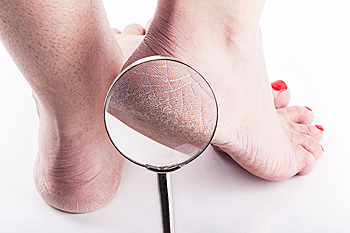 Winter can bring on many ailments, including skin on the heels that split, which is often referred to as cracked heels. Typically, this originates from dry skin, and the cold weather may cause the skin to lose moisture. If this is coupled with other conditions, such as diabetes or circulation issues, the results may lead to developing cracked heels. There are several symptoms of this ailment, often including itching, and the skin becoming thick and possibly flaking. If the fissures, or cracks, in the skin become severe, the possibility of an infection may occur. Prevention of this condition can consist of utilizing a moisturizer on your feet while paying extra attention when applying cream to the heels. Recent research has suggested that eating a diet consisting of fruits and vegetables may help to prevent cracked heels from the inside out. Please consider a consultation with a podiatrist if you have cracked heels and would like additional information.
Winter can bring on many ailments, including skin on the heels that split, which is often referred to as cracked heels. Typically, this originates from dry skin, and the cold weather may cause the skin to lose moisture. If this is coupled with other conditions, such as diabetes or circulation issues, the results may lead to developing cracked heels. There are several symptoms of this ailment, often including itching, and the skin becoming thick and possibly flaking. If the fissures, or cracks, in the skin become severe, the possibility of an infection may occur. Prevention of this condition can consist of utilizing a moisturizer on your feet while paying extra attention when applying cream to the heels. Recent research has suggested that eating a diet consisting of fruits and vegetables may help to prevent cracked heels from the inside out. Please consider a consultation with a podiatrist if you have cracked heels and would like additional information.
Cracked heels are unsightly and can cause further damage to your shoes and feet. If you have any concerns, contact Shaun J. Limon, DPM and Lisa Griffith-Limon, DPM from Limons Foot & Ankle Care. Our doctors can provide the care you need to keep you pain-free and on your feet.
Cracked Heels
Cracked heels appear unappealing and can make it harder for you walk around in sandals. Aside from looking unpleasant, cracked heels can also tear stockings, socks, and wear out your shoes. There are several methods to help restore a cracked heel and prevent further damage.
How Do You Get Them?
Dry skin is the number one culprit in creating cracked heels. Many athletes, walkers, joggers, and even swimmers suffer from cracked heels. Age and skin oil production play a role to getting cracked heels as well.
Promote Healing
Over the counter medicines can help, especially for those that need instant relief or who suffer from chronic dry feet.
Wear Socks – Wearing socks with medicated creams helps lock in moisture.
Moisturizers – Applying both day and night will help alleviate dryness which causes cracking.
Pumice Stones – These exfoliate and remove dead skin, which allows for smoother moisturizer application and better absorption into the skin.
Change in Diet
Eating healthy with a well-balanced diet will give the skin a fresh and radiant look. Your body responds to the kinds of food you ingest. Omega-3 fatty acids and zinc supplements can also revitalize skin tissue.
Most importantly, seek professional help if unsure how to proceed in treating cracked heels. A podiatrist will help you with any questions or information needed.
If you have any questions, please feel free to contact our offices located in Bradenton and Lakewood Ranch, FL . We offer the newest diagnostic and treatment technologies for all your foot care needs.
Read more about Solutions for Cracked HeelsDo Your Child's Feet Hurt?
Possible Causes of Bunions
 A lump that is hard, swollen, and red that forms on the outside edge of the foot is referred to as a bunion. It typically causes pain and discomfort and often becomes worse by wearing tight shoes. The big toe commonly turns out toward the other toes, and the skin is painful when the bunion is touched. Additionally, it may feel warm, which may be a result of inflammation. Having a predisposed, inherited gene is a contributing factor for this condition. Once it’s confirmed that you have the ailment, a decision will be necessary for treatment. Although removal of the bunion through surgery is the permanent way to relieve yourself of this condition, there may be a level of comfort that can be attained by purchasing shoes that are wider to accommodate the bunion. Additionally, specialty insoles and bunion pads may aid in providing relief. If you are experiencing discomfort from a bunion, a consultation with a podiatrist is suggested.
A lump that is hard, swollen, and red that forms on the outside edge of the foot is referred to as a bunion. It typically causes pain and discomfort and often becomes worse by wearing tight shoes. The big toe commonly turns out toward the other toes, and the skin is painful when the bunion is touched. Additionally, it may feel warm, which may be a result of inflammation. Having a predisposed, inherited gene is a contributing factor for this condition. Once it’s confirmed that you have the ailment, a decision will be necessary for treatment. Although removal of the bunion through surgery is the permanent way to relieve yourself of this condition, there may be a level of comfort that can be attained by purchasing shoes that are wider to accommodate the bunion. Additionally, specialty insoles and bunion pads may aid in providing relief. If you are experiencing discomfort from a bunion, a consultation with a podiatrist is suggested.
If you are suffering from bunions, contact Shaun J. Limon, DPM and Lisa Griffith-Limon, DPM of Limons Foot & Ankle Care. Our doctors can provide the care you need to keep you pain-free and on your feet.
What Is a Bunion?
A bunion is formed of swollen tissue or an enlargement of boney growth, usually located at the base joint of the toe that connects to the foot. The swelling occurs due to the bones in the big toe shifting inward, which impacts the other toes of the foot. This causes the area around the base of the big toe to become inflamed and painful.
Why Do Bunions Form?
Genetics – Susceptibility to bunions are often hereditary
Stress on the feet – Poorly fitted and uncomfortable footwear that places stress on feet, such as heels, can worsen existing bunions
How Are Bunions Diagnosed?
Doctors often perform two tests – blood tests and x-rays – when trying to diagnose bunions, especially in the early stages of development. Blood tests help determine if the foot pain is being caused by something else, such as arthritis, while x-rays provide a clear picture of your bone structure to your doctor.
How Are Bunions Treated?
- Refrain from wearing heels or similar shoes that cause discomfort
- Select wider shoes that can provide more comfort and reduce pain
- Anti-inflammatory and pain management drugs
- Orthotics or foot inserts
- Surgery
If you have any questions, please feel free to contact our offices located in Bradenton and Lakewood Ranch, FL . We offer the newest diagnostic and treatment technologies for all your foot care needs.
Read more about BunionsHow to Prevent Blisters on the Feet
If you see a small area filled with clear fluid on your foot, you may have what is referred to as blister. It’s common for joggers to develop blisters on the feet, and their running is often compromised. Pain and discomfort are often associated with blisters, and the best way to avoid this condition from occurring is to be aware of how to prevent it. It’s important to wear running shoes that fit correctly, and this includes choosing a shoe size that is bigger than shoes that are worn while not running. Additionally, there are socks that are designed specifically for running, and blisters may not form as rapidly when worn. Typically, the best way to treat a blister is to leave it alone, and it will heal on its own. If it bursts and becomes infected, a bandage may be necessary to cover it for protection. Please schedule a consultation with a podiatrist if you would like information about blisters on the feet and how to treat them.
Blisters are prone to making everyday activities extremely uncomfortable. If your feet are hurting, contact Shaun J. Limon, DPM and Lisa Griffith-Limon, DPM of Limons Foot & Ankle Care. Our doctors can provide the care you need to keep you pain-free and on your feet.
Foot Blisters
Foot blisters develop as a result of constantly wearing tight or ill-fitting footwear. This happens due to the constant rubbing from the shoe, which can often lead to pain.
What Are Foot Blisters?
A foot blister is a small fluid-filled pocket that forms on the upper-most layer of the skin. Blisters are filled with clear fluid and can lead to blood drainage or pus if the area becomes infected.
How Do Blisters Form?
Blisters on the feet are often the result of constant friction of skin and material, usually by shoe rubbing. Walking in sandals, boots, or shoes that don’t fit properly for long periods of time can result in a blister. Having consistent foot moisture and humidity can easily lead to blister formation.
Prevention & Treatment
It is important to properly care for the affected area in order to prevent infection and ease the pain. Do not lance the blister and use a Band-Aid to provide pain relief. Also, be sure to keep your feet dry and wear proper fitting shoes. If you see blood or pus in a blister, seek assistance from a podiatrist.
If you have any questions, please feel free to contact our offices located in Bradenton and Lakewood Ranch, FL . We offer the newest diagnostic and treatment technologies for all your foot care needs.
Read more about Blisters on the FeetBefore you start dancing...
More...
Causes of Hammertoe
 Hammertoe is caused by a deformity that bends the toes, causing them to be crooked. The joint affected is located at the bottom of the big toe and can often appear unsightly. The skin on top of the toes may look swollen, and corns and calluses will often form there, typically caused by friction as it rubs against the shoes. Causes of hammertoe are commonly due to shoes fitting poorly, which may cause the toes to be constricted for long periods of time. There may be a predisposed genetic trait that may cause this condition, in addition to diabetic patients and arthritis sufferers being prone to hammertoe. There are numerous treatment options available, depending on the severity of this condition. A consultation with a podiatrist is suggested for a proper diagnosis.
Hammertoe is caused by a deformity that bends the toes, causing them to be crooked. The joint affected is located at the bottom of the big toe and can often appear unsightly. The skin on top of the toes may look swollen, and corns and calluses will often form there, typically caused by friction as it rubs against the shoes. Causes of hammertoe are commonly due to shoes fitting poorly, which may cause the toes to be constricted for long periods of time. There may be a predisposed genetic trait that may cause this condition, in addition to diabetic patients and arthritis sufferers being prone to hammertoe. There are numerous treatment options available, depending on the severity of this condition. A consultation with a podiatrist is suggested for a proper diagnosis.
Hammertoe
Hammertoes can be a painful condition to live with. For more information, contact Shaun J. Limon, DPM and Lisa Griffith-Limon, DPM from Limons Foot & Ankle Care. Our doctors will answer any of your foot- and ankle-related questions.
Hammertoe is a foot deformity that affects the joints of the second, third, fourth, or fifth toes of your feet. It is a painful foot condition in which these toes curl and arch up, which can often lead to pain when wearing footwear.
Symptoms
- Pain in the affected toes
- Development of corns or calluses due to friction
- Inflammation
- Redness
- Contracture of the toes
Causes
Genetics – People who are genetically predisposed to hammertoe are often more susceptible
Arthritis – Because arthritis affects the joints in your toes, further deformities stemming from arthritis can occur
Trauma – Direct trauma to the toes could potentially lead to hammertoe
Ill-fitting shoes – Undue pressure on the front of the toes from ill-fitting shoes can potentially lead to the development of hammertoe
Treatment
Orthotics – Custom made inserts can be used to help relieve pressure placed on the toes and therefore relieve some of the pain associated with it
Medications – Oral medications such as anti-inflammatories or NSAIDs could be used to treat the pain and inflammation hammertoes causes. Injections of corticosteroids are also sometimes used
Surgery – In more severe cases where the hammertoes have become more rigid, foot surgery is a potential option
If you have any questions please contact our offices located in Bradenton and Lakewood Ranch, FL . We offer the newest diagnostic and treatment technologies for all your foot and ankle needs.
Read more about What Are Hammertoes?Proper Foot Stretches for Ballet Dancers
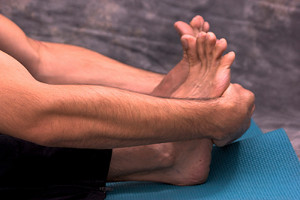 If you’re a ballet dancer, performing proper stretches for the feet is crucial in maintaining an eloquent and graceful form. The feet need to feel strong to execute perfect dancing, and implementing correct stretches are necessary in achieving this. The tendon in the body that connects the back of the leg to the lower heel is referred to as the Achilles tendon, and this must be stretched to avoid any tears or strains. An inflammation can be caused by damage that’s inflicted on this tendon, which may often result in severe pain. An effective stretch for the Achilles tendon is to stand on a staircase, with one foot hanging off the step. Gently flex the foot, and this will properly stretch the tendons and muscles in the foot. When this is accomplished, you can switch feet. Ballet dancers tend to put enormous pressure on the big toe, and there are certain stretches that can possibly prevent any injuries from occurring. Grasping your big toe and pulling it back toward your body will not only enable the joint to remain flexible, but will also stretch the sole of the foot for improved mobility. Keeping the feet strong and flexible is accomplished by choosing to perform the correct stretching techniques.
If you’re a ballet dancer, performing proper stretches for the feet is crucial in maintaining an eloquent and graceful form. The feet need to feel strong to execute perfect dancing, and implementing correct stretches are necessary in achieving this. The tendon in the body that connects the back of the leg to the lower heel is referred to as the Achilles tendon, and this must be stretched to avoid any tears or strains. An inflammation can be caused by damage that’s inflicted on this tendon, which may often result in severe pain. An effective stretch for the Achilles tendon is to stand on a staircase, with one foot hanging off the step. Gently flex the foot, and this will properly stretch the tendons and muscles in the foot. When this is accomplished, you can switch feet. Ballet dancers tend to put enormous pressure on the big toe, and there are certain stretches that can possibly prevent any injuries from occurring. Grasping your big toe and pulling it back toward your body will not only enable the joint to remain flexible, but will also stretch the sole of the foot for improved mobility. Keeping the feet strong and flexible is accomplished by choosing to perform the correct stretching techniques.
Stretching the feet is a great way to prevent injuries. If you have any concerns with your feet consult with Shaun J. Limon, DPM and Lisa Griffith-Limon, DPM from Limons Foot & Ankle Care. Our doctors will assess your condition and provide you with quality foot and ankle treatment.
Stretching the Feet
Being the backbone of the body, the feet carry your entire weight and can easily become overexerted, causing cramps and pain. As with any body part, stretching your feet can serve many benefits. From increasing flexibility to even providing some pain relief, be sure to give your feet a stretch from time to time. This is especially important for athletes or anyone performing aerobic exercises, but anyone experiencing foot pain or is on their feet constantly should also engage in this practice.
Great ways to stretch your feet:
- Crossing one leg over the others and carefully pull your toes back. Do 10-20 repetitions and repeat the process for each foot
- Face a wall with your arms out and hands flat against the wall. Step back with one foot and keep it flat on the floor while moving the other leg forward. Lean towards the wall until you feel a stretch. Hold for 30 seconds and perform 10 repetitions for each foot
- Be sure not to overextend or push your limbs too hard or you could risk pulling or straining your muscle
Individuals who tend to their feet by regular stretching every day should be able to minimize foot pain and prevent new problems from arising.
If you have any questions, please feel free to contact our offices located in Bradenton and Lakewood Ranch, FL . We offer the newest diagnostic and treatment technologies for all your foot care needs.
Read more about Stretching Your FeetWounds That Don't Heal Need to Be Checked
Causes of Gout
 If inflammation is experienced, often resulting in severe pain located in the foot, you may have a condition referred to as gout. This condition is caused by a large amount of uric acid in the blood, which is a waste product secreted by the kidneys. Crystals are formed by excessive uric acid which adheres to the joints, causing severe inflammation. There are many causes of gout, including predisposed inherited genes, kidney disease, obesity, diet, and high blood pressure. If a healthy lifestyle is practiced, which includes limiting alcohol and avoiding foods that cause elevated uric acid levels, the attacks may be controlled. Please consider scheduling a consultation with a podiatrist for more information about gout.
If inflammation is experienced, often resulting in severe pain located in the foot, you may have a condition referred to as gout. This condition is caused by a large amount of uric acid in the blood, which is a waste product secreted by the kidneys. Crystals are formed by excessive uric acid which adheres to the joints, causing severe inflammation. There are many causes of gout, including predisposed inherited genes, kidney disease, obesity, diet, and high blood pressure. If a healthy lifestyle is practiced, which includes limiting alcohol and avoiding foods that cause elevated uric acid levels, the attacks may be controlled. Please consider scheduling a consultation with a podiatrist for more information about gout.
Gout is a foot condition that requires certain treatment and care. If you are seeking treatment, contact Shaun J. Limon, DPM and Lisa Griffith-Limon, DPM from Limons Foot & Ankle Care. Our doctors will treat your foot and ankle needs.
What Is Gout?
Gout is a type of arthritis caused by a buildup of uric acid in the bloodstream. It often develops in the foot, especially the big toe area, although it can manifest in other parts of the body as well. Gout can make walking and standing very painful and is especially common in diabetics and the obese.
People typically get gout because of a poor diet. Genetic predisposition is also a factor. The children of parents who have had gout frequently have a chance of developing it themselves.
Gout can easily be identified by redness and inflammation of the big toe and the surrounding areas of the foot. Other symptoms include extreme fatigue, joint pain, and running high fevers. Sometimes corticosteroid drugs can be prescribed to treat gout, but the best way to combat this disease is to get more exercise and eat a better diet.
If you have any questions please feel free to contact our offices located in Bradenton and Lakewood Ranch, FL . We offer the newest diagnostic and treatment technologies for all your foot and ankle needs.
Read more about Everything You Need to Know About Gout